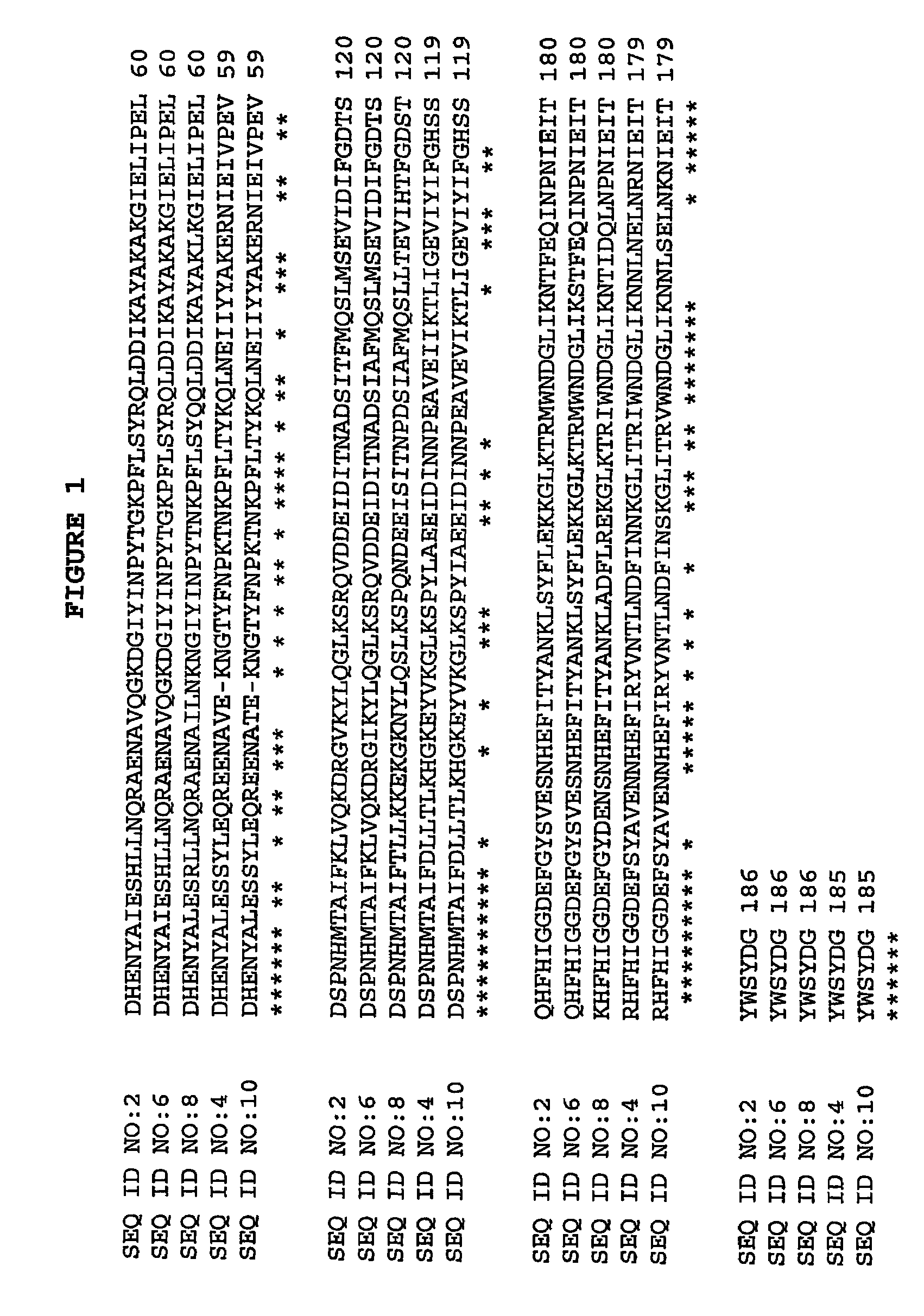Compositions and methods for enzymatic detachment of bacterial and fungal biofilms
a biofilm and enzyme detachment technology, applied in the direction of antibacterial agents, drug compositions, peptide/protein ingredients, etc., can solve the problems of biofilm infection affecting tens of millions of patients, requiring a significant health care expenditure, and a significant threat to human health, so as to prevent the spread of infectious bacteria
- Summary
- Abstract
- Description
- Claims
- Application Information
AI Technical Summary
Benefits of technology
Problems solved by technology
Method used
Image
Examples
example 1
Bacterial Strains and Growth Conditions
[0081]A. actinomycetemcomitans CU1000 (serotype f) is a clinical strain isolated from a 13 year old patient with localized juvenile periodontitis (Fine et al. Microbiol. 1999 145:1335-1347). Strain CU1000N is a spontaneous nalidixic acid derivative of strain CU1000 that displays the same surface attachment, biofilm colony formation and biofilm dispersal phenotypes as the parental strain (Fine et al. Arch. Oral Biol. 2001 46:1065-1078; Kachlany et al. J. Bacteriol. 2000 182:6169-6176; Kachlany et al. Mol. Microbiol. 2001 40:542-554; Thomson et al. J. Bacteriol. 1999 181:7298-7307). Mutagenesis of strain CU1000N with transposon IS903φkan was carried in accordance with the procedures set forth by Thomson et al. (J. Bacteriol. 1999 181:7298-7307). Other strains utilized include A. actinomycetemcomitans DF2200 (serotype a), NJ8800 (serotype b), NJ2700 (serotype c), and NJ9500 (serotype e) (Kaplan et al. J. Clin. Microbiol. 2002 40:1181-1187); and A....
example 2
Cloning and Sequencing dspB
[0082]The transposon insertion site in A. actinomycetemcomitans mutant strain JK1023 was cloned and sequenced by using an inverse PCR method in accordance with Kaplan et al. (Infect. Immun. 2001 69:5375-5384). The DNA sequence of the inverse PCR product was compared to the genome sequence of A. actinomycetemcomitans strain HK1651 from the Actinobacillus Genome Sequencing Project and the transposon was found to have inserted into a long open reading frame (ORF) which was designated dspb. Primers that hybridize to sequences upstream and downstream from HK1651 dspB were used to amplify by PCR the dspB coding region from A. actinomycetemcomitans strain CU1000 using methods in accordance with Kaplan et al. (Infect. Immun. 2001 69:5375-5384). The forward primer (5-GCGCGCCAatgAATTGTTGCGTAAAAGGCAATTCC-3 (SEQ ID NO:14)) introduced an NdeI restriction site (underlined) and an ATG initiation codon (lower case) at codon positions 19 to 20 of dspB, and the reverse prim...
example 3
Expression and Purification of Recombinant
Dispersin B Protein
[0083]Plasmid pRC1 carries a gene that encoded amino acids 21 to 381 of dspB fused to a 32 amino acid residue C-terminal tail containing an hexahistidine metal-binding site and a thrombin protease cleavage site which could be used to cleave the C-terminal tail from the hybrid protein. This gene was located downstream from an isopropyl-β-D-thiogalactopyranoside (IPTG)-inducible tac promoter.
Expression of DspB in E. coli
[0084]A one liter Erlenmeyer flask containing 500 ml of LB broth supplemented with 50 μg / ml of kanamycin was inoculated with 5 ml of an overnight culture of E. coli strain BL21(DE3) (Dubendorff, J. W. and Studier, F. W. J. Mol. Biol. 1991 219:61-68) transformed with pRC1. The flask was incubated at 37° C. with agitation (200 rpm) until the optical density of the culture (measured at 280 nm) reached 0.6 (approximately 3 hours). IPTG was added to a final concentration of 0.2 mM and the flask was incubated for ...
PUM
| Property | Measurement | Unit |
|---|---|---|
| molecular mass | aaaaa | aaaaa |
| temperature | aaaaa | aaaaa |
| temperature | aaaaa | aaaaa |
Abstract
Description
Claims
Application Information
 Login to View More
Login to View More - R&D
- Intellectual Property
- Life Sciences
- Materials
- Tech Scout
- Unparalleled Data Quality
- Higher Quality Content
- 60% Fewer Hallucinations
Browse by: Latest US Patents, China's latest patents, Technical Efficacy Thesaurus, Application Domain, Technology Topic, Popular Technical Reports.
© 2025 PatSnap. All rights reserved.Legal|Privacy policy|Modern Slavery Act Transparency Statement|Sitemap|About US| Contact US: help@patsnap.com

